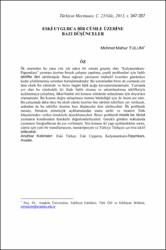Eski Uygurca Bir Cümle Üzerine Bazı Düşünceler
Abstract
İlk neşrinden bu yana yüz yılı aşkın bir zaman geçmiş olan "KalyanamkaraPapamkara" yazması üzerine birçok çalışma yapılmış, çeşitli problemleri için farklı teklifler ileri sürülmüştür. Buna rağmen yazmanın muhtelif kısımları günümüze kadar çözülememiş sorunları barındırmaktadır. Bu sorunlardan birisi de yazmada yer alan eksik bir cümledir ve bizce bugün hâlâ açığa kavuşturulamamıştır. Yazmada yer alan bu cümledeki iki ifade farklı okuma ve anlamlandırma teklifleriyle açıklanmaya çalışılmış, fakat bunlar söz konusu cümlenin anlaşılması için doyurucu olamamıştır. Bu kısmın doğru anlaşılması metnin bütünlüğü için de önem arz eder. Bu çalışmada daha önce bu eksik cümle üzerine öne sürülen tekliflere yer verilecek, ardından da bu teklifler üzerine bazı düşünceler ileri sürülecektir. İlk problemli mesele, birtakım etimolojik açıklamalardan sonra tarihî ve modern Türk lehçelerinden verilen örneklerle desteklenecektir. İkinci problemli mesele ise, bizzat yazmanın kendisinden hareketle değerlendirilecektir. Gerekli görülen noktalarda yazmanın fotoğraflarına da yer verilmiştir. Söz konusu iki yapı açıklandıktan sonra, cümle için yeni bir transliterasyon, transkripsiyon ve Türkiye Türkçesi çevirisi teklif edilecektir Many studies have been conducted on Kalyanamkara-Papamkara manuscript which more than hundred years have passed over its first publication and different proposals are suggested to its different sections. Despite this various sections of the manuscript contains the problems which couldn?t have been solved until today. One of these problems is the elliptical sentence contained in the manuscript. Basically the two important structures contained in the manuscript are tried to be explained by means of different reading and interpretations but they couldn?t have been sufficient to understand the said sentence. Thus, it prevented understanding of the whole of text. In this study, the assertions made on the elliptical sentence will be given place and then ideas about these assertions will be set forth. The first problematical structure will be tried to be explained by giving places to the examples from historical and modern Turkish dialects. The second problematic structure will be examined by dealing as manuscript centred entirely. The photos of the manuscript will be given place required for all these. Lastly, after the two structures explained, a new transliteration, transcription and translation in to Turkey Turkish of the said sentence will be offered
Source
Türkiyat MecmuasıVolume
25Issue
GÜZURI
http://www.trdizin.gov.tr/publication/paper/detail/TWpNMk1EZzBOQT09https://hdl.handle.net/11421/14235


















